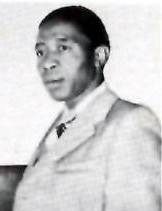Herbert Dhlomo

Herbert I. E. Dhlomo (1903 – 1956) the younger brother of R.R.R. Dhlomo, was born in Siyama Village near Pietermaritzburg, Natal, South Africa. In the thirties he was appointed to the staff of the Bantu World, a weekly journal, and later was assistant editor of Ilanga lase Natal. He died at King Edward Hospital in Durban on October 23, 1956. Dhlomo’s first work is also the first drama published in English by a black South African author
Entitled The Girl Who Killed to Save (1936), it is based on an episode of the Xhosa history, the cattle- killing tragedy of 1857. The Valley of Thousand Hills (1941) is a long elegiac poem, based on the contrast between the harmony of nature, and the cruelty and ugliness of human society. Three of Dhlomo’s plays, dealing with the Zulu kings Shaka, Cetshwayo and the paramount chief and founder of the Sotho nation, Moshesh, “were meant to be published in one book, which the author intended to call The Black Bulls” (B.W. Vilakazi). Apparently, none of these works ever reached print.
Chaka – a Tragedy (1936), however, was performed by the African Dramatic Society in Johannesburg. Dhlomo also dealt with Zulu oral art in a series of articles. His controversy with B.W. Vilakazi about form and content of Bantu literature is probably the first controversy in the history of African literature.
‘Dhlomo provides one of the most lucid expositions of the societal significance of folk art, and especially praise poetry, to have come from the pen of an African’
(Albert S. Gerard).
Wikipedia: https://en.wikipedia.org/wiki/Herbert_Isaac_Ernest_Dhlomo Selected Work
from Dingana (Adapted performance script. First performed by the Medical Students’ Drama Group of the University of Natal, 28 May 1954.)
JEQE: Shaka – The man who set the world on fire: It is right that I should spend my last moments speaking in his praise, O countryside, O hills, O cattle paths and winding streams – how much he loved these things, Shaka, King of Men, the Black One, in the listening hours of night we sought the path, he and I, to the inner mystery of life, the soul of watching mountains and the pregnant darkness. For beauty of bird or woman or evening strangely stabbed him, and in all his wildest acts, I believe, he sought the blood of beauty, and the heart of it.
NTOMBAZI: How wonderful, the Zulu tongue; strong, and full of stabbing music.
JEQE: Is it?
NTOMBAZI: Your speech is song.
JEQE: Ha, in Zululand we run to eloquence; we are all orators and bards.
NTOMBAZI: Are you not hungry and thirsty after all your trials?
JEQE: You are a woman who understands the language of the stomach.
NTOMBAZI: Here is water.
JEQE: (Drinking) Water is like a woman, cool, sweet, and lovely.
#NTOMBAZI: The pot is like you, warrior; big, strong, and empty.
JEQE: Indeed I am still empty.
NTOMBAZI: There is food in the village.
JEQE: Whose village is it?
NTOMBAZI: Ntombazi’s.
JEQE: Ntombazi. She, that great healer.
NTOMBAZI: And slayer.
JEQE: And slayer. The renowned doctor of Swaziland. So far from death I’ve come to death, for the Zulus who come here never return.
NTOMBAZI: Yes, in Zululand you make words; in Swaziland we make medicine. This is a land of doctors: almost every grown-up person here knows which roots and leaves are medicinal – and which have power to kill.
JEQE: I wish some of us knew more about such things, and less about forging arms. Yet medicine has its own evils. It is made of insects, lowly creatures, and herbs: wild and earthy things. So it has two powers: a power for life and, a power of destruction.
Bibliography
1936. Chaka: A Tragedy. Johannesburg: African Dramatic Society.
1936. The Girl who Killed to Save: Nongqause the Liberator. Eastern Cape: Lovedale Press.
1941. Valley of a Thousand Hills. Durban: The Knox Publishing Company.
1954. Dingana: A Play. Durban: University of Natal Press.